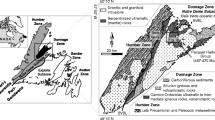Abstract
Fourteen stratiform, stratabound and vein-type sulphide occurrences in the Upper Allochthon of the Central–North Norwegian Caledonides have been studied for their sulphur, oxygen and hydrogen isotope composition. Depositional ages of host rocks to the stratabound and stratiform sulphide occurrences range from 590 to 640 Ma. The sulphides and their host rocks have been affected by polyphase deformation and metamorphism with a peak temperature of 650 °C dated to 432 Ma. A total of 104 sulphide and 2 barite samples were analysed for δ34S, 16 whole-rock and quartz samples for δ18O and 12 samples of muscovite for δD. The overall δ34S values range from −14 to +31‰ with the majority of sampled sulphides lying within a range of +4 to +15‰. In most cases δ34S within each hand specimen behaves in accordance with the equilibrium fractionation sequence, δ34Sgn<δ34Scp<δ34Ssph<δ34Spy. A systematic increase in δ34S from the vein sulphides (−8‰) through schist/amphibolite-hosted (+6‰) and schist-hosted (+7 to +12‰) to dolomite-hosted (+12 to +31‰) occurrences is documented. The δ34S averages of the stratiform schist-hosted sulphides are 17 to 22‰ lower than in the penecontemporaneous seawater sulphate. The Bjørkåsen (+4 to +6‰) occurrence is a volcanogenic massive sulphide (VMS) transitional to sedimentary massive sulphide (SMS), exhalative, massive, pyritic deposit of Cu–Zn–Pb sulphides formed by fluids which obtained H2S via high-temperature reduction of seawater sulphate by oxidation of Fe2+ during the convective circulation of seawater through underlying rock sequences. The Raudvatn, volcanic-hosted, disseminated Cu sulphides (+6 to +8‰) obtained sulphur via a similar process. The Balsnes, stratiform, ‘black schist’-hosted, pyrite–pyrrhotite occurrence (−6 to −14‰) is represented by typical diagenetic sulphides precipitated via bacteriogenic reduction of coeval (ca. 600 Ma) seawater sulphate (+25 to +35‰) in a system open to sulphate supply. The δ34S values of the Djupvik–Skårnesdalen (+7 to +12‰), Hammerfjell (+5 to 11‰), Kaldådalen (+10 to +12‰) and Njallavarre (+7 to +8‰) stratiform, schist-hosted, massive and disseminated Zn–Pb (±Cu) sulphide occurrences, as well as the stratabound, quartzite-hosted, Au-bearing arsenopyrite occurrence at Langvatnet (+7 to +11‰), suggest that thermochemically reduced connate seawater sulphate was a principal sulphur source. The Sinklien and Tårstad, stratabound, dolomite- and dolomite collapse breccia-hosted, Zn (±Cu–Pb) sulphides are marked by the highest enrichment in 34S (+20 to +31‰). The occurrences are assigned to the Mississippi-Valley-type deposits. High δ34S values require reduction/replacement of contemporaneous (ca. 590 Ma) evaporitic sulphate (+23 to +34‰) with Corg-rich fluids in a closed system. The Melkedalen (+12 to +15‰), stratabound, fault-controlled, Cu–Zn sulphide deposit is hosted by the ca. 595 Ma dolomitised Melkedalen marble. The deposit is composed of several generations of ore minerals which formed by replacement of host dolomite. Polyphase hydrothermal fluids were introduced during several reactivation episodes of the fault zone. The positive δ34S values with a very limited fractionation (<3‰) are indicative of the sulphide-sulphur generated through abiological, thermochemical reduction of seawater sulphate by organic material. The vein-type Cu (±Au–W) occurrences at Baugefjell, Bugtedalen and Baugevatn (−8 to −4‰) are of hydrothermal origin and obtained their sulphur from igneous sources with a possible incorporation of sedimentary/diagenetic sulphides. In a broad sense, all the stratiform/stratabound, sediment-hosted, sulphide occurrences studied formed by epigenetic fluids within two probable scenarios which may be applicable separately or interactively: (1) expulsion of hot metal-bearing connate waters from deeper parts of sedimentary basins prior to nappe translation (late diagenetic/catagenetic/epigenetic fluids) or (2) tectonically driven expulsion in the course of nappe translation (early metamorphic fluids). A combination of (1) and (2) is favoured for the stratabound, fault-controlled, Melkedalen and Langvatnet occurrences, whereas the rest are considered to have formed within option (1). The sulphides and their host rocks were transported from unknown distances and thrust on to the Fennoscandian Shield during the course of the Caledonian orogeny. The displaced/allochthonous nature of the Ofoten Cu–Pb–Zn ‘metallogenetic province’ would explain the enigmatically high concentration of small-scale Cu–Pb–Zn deposits that occur only in this particular area of the Norwegian Caledonides.
Similar content being viewed by others
Author information
Authors and Affiliations
Additional information
Received: 10 March 1999 / Accepted: 8 January 2000
Rights and permissions
About this article
Cite this article
Melezhik, V., Lindahl, I., Pokrovsky, B. et al. Sulphur source and genesis of polymetallic sulphide occurrences of the Ofoten district in the Central–North Norwegian Caledonides: evidence from sulphur isotopic studies. Mineral. Deposita 35, 465–489 (2000). https://doi.org/10.1007/s001260050256
Issue Date:
DOI: https://doi.org/10.1007/s001260050256




